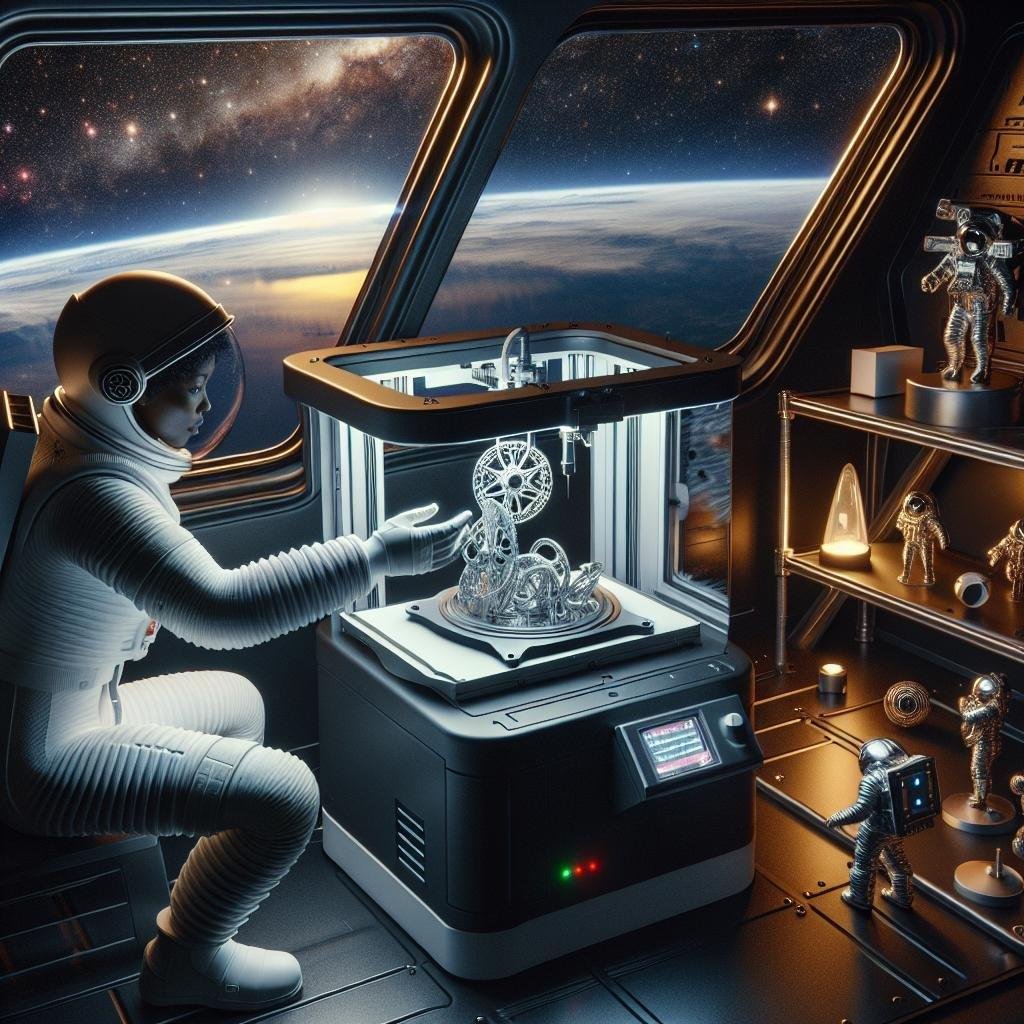In the vast, starry tapestry of the cosmos, space exploration has always been humanity’s ultimate adventure-a quest not only to understand the universe but to push the boundaries of what we can achieve. Now, imagine a world where these boundaries are not defined by what we can send into the cold abyss of space, but by what we can create anew, right in the depths of the void. Welcome to the future of 3D printing in space exploration,where innovation meets inventiveness to forge a path toward limitless possibilities. As we prepare to set foot on new worlds and uncover the secrets of distant galaxies, 3D printing emerges as a game-changing tool, poised to revolutionize everything from spacecraft construction to the very habitats we will call home far from Earth. Join us as we embark on a journey into tomorrow’s universe, where the only limit is our imagination and each click of the printer’s nozzle echoes with the potential to reshape the stars themselves.
Pushing Boundaries: How 3D Printing Transforms Space Travel
In an era where every kilogram lifted into orbit represents remarkable costs, the advent of 3D printing technology is revolutionizing how we approach space exploration. This technology enables on-demand manufacturing of components, sparking the imagination of scientists and engineers worldwide. Imagine the possibility of astronauts crafting the tools and parts they need, right on the International Space Station. the flexibility 3D printing offers allows for repairs and modifications without waiting for the next resupply mission. This capability extends far beyond mere tools, envisioning the construction of habitats from locally sourced materials on lunar or Martian soil. By harnessing this technology, missions can be more cost-effective and less reliant on Earth-based resources.
- Reduced Launch Weight: Manufacture in space means sending fewer spare parts from Earth.
- Resource Utilization: Local material usage on Mars or the Moon for habitat construction.
- Rapid Prototyping: Fast design updates to meet mission needs.
Additionally,space agencies are exploring how 3D printing can be utilized for even more ambitious projects. As research progresses, the idea of creating and deploying satellites directly in orbit is becoming viable. This possibility suggests that organizations could rapidly expand existing satellite networks or replace compromised units without waiting for Earth-based deployments. Consider the following potential applications:
| Request | Potential Impact |
|---|---|
| Satellite Printing | Faster response to technological advancements. |
| On-Demand Manufacturing | Customization of mission-specific equipment. |
With such transformative possibilities, future space missions may carry a fleet of printers rather than payloads of spare parts, marking a groundbreaking shift in how humanity approaches the final frontier.

Innovative Materials: The Building Blocks of Interstellar Construction
In the quest to redefine possibilities, the use of innovative materials in 3D printing has brought us to the exciting frontier of interstellar construction. From lunar bases to Mars outposts, these cutting-edge materials harnessed for 3D printing are designed to withstand the harshness of other worlds. Here’s a rundown of some transformative materials shaping our space-faring future:
- Regolith-based Structures: Utilizing extraterrestrial soil to build habitats reduces the need for carrying heavy materials from Earth, easing space travel logistical challenges.
- Metal Alloys: custom-engineered to be lightweight yet durable, these alloys ensure structural stability under cosmic radiation and extreme temperatures.
- Aerogels: Known for their amazing insulating properties, aerogels contribute to both thermal protection and micrometeorite defense.
- Polymers: Advanced polymers incorporate self-healing properties, ensuring longevity and resilience of structures even in the face of unexpected damages.
Given the variability between planetary conditions, the role of materials science in space exploration cannot be understated. Take a look at how these materials stack up in terms of unique properties:
| Material | Unique Property | Application |
|---|---|---|
| Regolith | Abundance in soil | Construction on the Moon |
| Metal Alloys | strength-to-weight ratio | Structural frames |
| Aerogels | Remarkable insulation | Habitat protection |
| Polymers | Self-healing | Flexible joints |

From Concept to Cosmos: Streamlining Production and Repair with 3D Printing
In the rapidly evolving landscape of space exploration, the role of 3D printing holds transformative potential, offering unprecedented flexibility and efficiency in the production and maintenance of spacecraft components. By embracing additive manufacturing,missions to distant cosmic realms can substantially reduce their dependency on Earth’s resupply through the direct fabrication of objects in zero-gravity environments. The implications are profound; it means that astronauts might soon be able to print intricate tools or crucial spacecraft parts on demand, minimizing space mission delays and costs. Some potential benefits of this advancement include:
- Reduced logistical challenges: No need for large stockpiles of spares.
- Enhanced mission adaptability: Quick response to unexpected challenges.
- Localized resource utilization: Use of extraterrestrial materials for 3D printing.
As we leverage 3D printing, engineers are begining to focus on the possibility of in-situ resource utilization (ISRU), where materials like lunar regolith or Martian soil could be used to construct habitats or other structures. This exciting progression increases autonomy in deep space missions, fostering an era where off-world manufacturing is not just possible but practical. here’s a quick look at some of the key areas where 3D printing is set to revolutionize space exploration:
| Area of Impact | Potential Application |
|---|---|
| Infrastructure Development | Building bases on the Moon or Mars |
| health & Safety | Production of medical tools and prosthetics for astronauts |
| Research & Analysis | Printing experimental devices and complex parts |

Setting Course for Success: Strategic Recommendations for integrating 3D Printing in Space missions
Embracing the possibilities that 3D printing holds for space exploration involves a nuanced approach,weaving innovation with meticulous planning. First and foremost, crafting a clear mission objective that aligns with both immediate and future space exploration goals is essential. whether it’s manufacturing tools on-demand for lunar bases or developing more sustainable habitats on Mars, the integration of 3D printing technology should be a intentional and strategic endeavor. A prosperous strategy should include a comprehensive evaluation of the specific materials needed for each mission, as different materials might be required for varying environments and functions.Space agencies could also benefit from fostering partnerships with tech companies that specialize in advanced materials and 3D printing solutions, ensuring that missions are equipped with the latest innovations.
Another pivotal element is the training and education of astronauts and mission specialists in 3D printing technologies. Equipping the crew with skills to troubleshoot and operate 3D printing equipment in microgravity environments is crucial for mission success. NASA and other agencies could develop specialized training modules interwoven with simulations that mimic space conditions. To streamline operations, integrating 3D printing with existing in-space manufacturing systems should also be prioritized. A collaborative approach can further amplify these efforts,with teams working across different space agencies to share insights and breakthroughs. Consider incorporating these elements into the mission fabric:
- Regular workshops and training sessions
- Joint research initiatives with private sector leaders
- Investment in adaptive 3D printing technologies
| Focus Area | Strategic Action |
|---|---|
| Material Selection | Evaluate environment-specific needs |
| Astronaut Training | Simulated microgravity courses |
| Technology integration | Collaborate with industry leaders |
Q&A
Q&A: The Future of 3D Printing in Space Exploration
Q1: What makes 3D printing so significant for space exploration?
A1: Imagine your on the Moon, contemplating a stunning Earthrise, when suddenly you need a crucial part for your lunar rover. You can’t exactly head to the nearest hardware store! This is where 3D printing becomes a game-changer. its magic lies in the ability to create tools, parts, or even entire habitats using locally sourced materials. This means less dependency on Earth shipments, which are both costly and time-consuming.
Q2: How does 3D printing reduce costs for space missions?
A2: Picture fitting your entire wardrobe, kitchen supplies, and garage into a suitcase; that’s what it feels like preparing a spacecraft. Every ounce counts, and shipping extra supplies is astronomically expensive. By printing items directly in space, we minimize the cargo weight, drastically lowering launch costs. Plus, with fewer supplies needed upfront, spacecraft can be smaller and more efficient-think sports car rather of a minivan!
Q3: What materials can be used in 3D printing in space?
A3: Here’s where it gets really sci-fi. Not only can we use customary materials like plastics and metals, but we’re also experimenting with regolith-the dust-like material covering celestial bodies. Imagine printing a lunar base out of… the moon itself! It’s the ultimate recycling project, transforming alien dust into sturdy structures.
Q4: Can astronauts rely on 3D printed items for critical repairs?
A4: Absolutely! In fact, 3D printers are already aboard the International Space Station (ISS) and have been successfully used for tools and replacements. The great thing about 3D printing is its flexibility-a tricky situation could be met with an innovative solution in a matter of hours, provided you have a good design file. It’s like having a universal toolbox that adapts to every need.
Q5: What about living structures? Could 3D printing help build habitats on Mars?
A5: The idea is not as “out there” as you might think! Prototypes of 3D-printed habitats are already being tested on Earth. These structures could withstand harsh planetary conditions and even self-repair in the event of meteor impacts or erosion. Basically, they provide a cozy place to call home, using the very ground you’re standing on. Martian real estate, anyone?
Q6: What’s next for 3D printing in space exploration?
A6: The future is as boundless as the cosmos. We’re looking at the possibility of manufacturing everything from satellites to entire spacecraft directly in orbit. this means less space debris and more flexibility in design-imagine launching only the essentials from Earth and constructing the rest in space. It’s like building with interstellar LEGO, paving the way for deeper space expeditions and even planetary colonization.In essence, 3D printing is the Switzerland Army Knife of space exploration-multifaceted, indispensable, and always evolving. As we reach for the stars, it promises to turn the impossible into the tangible, one printed layer at a time. Let’s print a new chapter in space exploration!
To Conclude
As we look to the stars, the promise of 3D printing in space exploration paints a future teeming with possibilities. The cosmic landscape is no longer just a backdrop for dreams, but a canvas upon which we can actively craft and innovate. Much like how we once marveled at the mysteries held within the night sky, we now stand on the cusp of a new frontier-one where imagination dances with technology amidst celestial wonders.With every layer added and each filament spun in the vastness of space, we are not just building tools or habitats; we are constructing our future among the stars. The universe is inviting us to stretch our ingenuity beyond Earthly confines-one printed object at a time.
Let us not just dream of worlds beyond, but actively build them. Here’s to a future where space is not just the final frontier, but a familiar neighborhood open to our exploration and creativity. Until then, may your curiosity know no bounds, and may the printer of imagination run ceaselessly.

